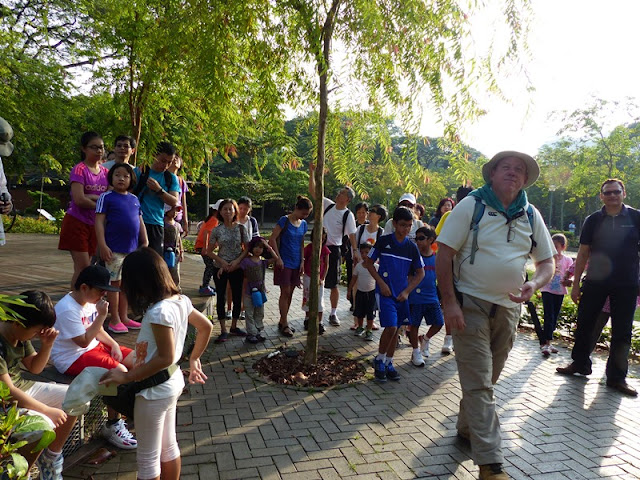Education Committee Chairperson
 |
| Uncle Tony leading a young entourage through the wonderful world of plants. |
The allure of meeting Forest Giants up close was enough to attract
a sizeable number of kids and their families to MacRitchie Reservoir (off Lornie Road in central Singapore) on the
morning of 23 November 2014. Plant Group Chairperson Uncle Tony O’Dempsey was our
esteemed guide, assisted by Auntie Angie Ng. Uncle Tony maintains an informative
compendium on Singapore’s flora at http://florasingapura.com/.
Uncle Tony started by pointing out shrubs such as the Simpoh Air (Dillenia suffruticosa) as we trooped
from the Visitor Centre towards the forest proper. Along the way, Auntie Angie paused
under a prominent Banyan Tree (Ficus
microcarpa), and told us that this strangling fig started life as a hemi-epiphyte.
This is when their seeds (usually dispersed by birds) germinate in crevices on
trees and even buildings. They eventually envelop their host tree with their
spreading prop trunks and roots. The original support tree can die from this
‘strangulation’. The strangling fig then becomes a ‘columnar tree’ with a
hollowed core. Uncle Tony also introduced two types of Pulai (Alstonia angustiloba and Alstonia scholaris), where both can be
differentiated by variations in leaf venation and patterning. Both Pulai
species can be found on the hillock that houses war hero’s Lim Bo Seng tomb.
 |
| Auntie Angie highlighting the strangling nature of the Banyan Tree. |
We then entered the cool forest trail that runs parallel to Lornie
Road. Uncle Tony showed us his favourite rattans. Rattans have spines on their
stems and leaves that serve to protect them from herbivores and help them cling
to the trunks of trees for support. They can reach hundreds of metres long. In
many tropical countries, people harvest rattans to make lightweight and durable
cane furniture or weave them into baskets and other craft. Uncle Tony pointed
out two types of Macaranga (Macaranga
gigantea and Macaranga bancana). Of
the 11 species of Macaranga found in Singapore, eight of them host ants in
their hollow twigs and produce food-bodies which supplement the ants’ diet. In
return, these ants protect the Macaranga from invasion by insects such as
caterpillars.
 |
| A Forest Giant with mighty buttress roots, a long straight trunk, and a spreading crown that towers over the canopy. |
Kids were suitably impressed with the few Forest Giants that we
came across. Typical of primary forests, Forest Giants are dominated by dipterocarps in the genera
Shorea, Dipterocarpus and Anisoptera. These are
characterised by long straight trunks reaching up to 50 metres, buttress roots and
broccoli-like crowns that break through the main canopy. Also called emergents,
these trees can be hundreds of years old.
 |
| Uncle Tony sharing about the importance of the rainforest. |
We encountered many other wonderful plants. There was a patch of Slender
Pitcher Plants (Nepenthes gracilis)
with a profusion of dangling pitchers that serve as traps for insects,
particularly during rainfall. The insects drown and are digested, benefiting
the plant with mineral nutrition (especially nitrogen and phosphorus) and protein.
Such carnivorous plants are able to colonise areas with mineral-poor or overly
acidic soil too tough for most other plants to survive. The walk ended with several animal sightings: frolicking
Long-tailed Macaques (Macaca fascicularis),
a dried-up Green Paddy Frog (Hylarana
erythraea) and a 1.5 m long Malayan Water Monitor (Varanus salvator).
 |
| Frolicking Long-tailed Macaques (Macaca fascicularis), |
No comments:
Post a Comment